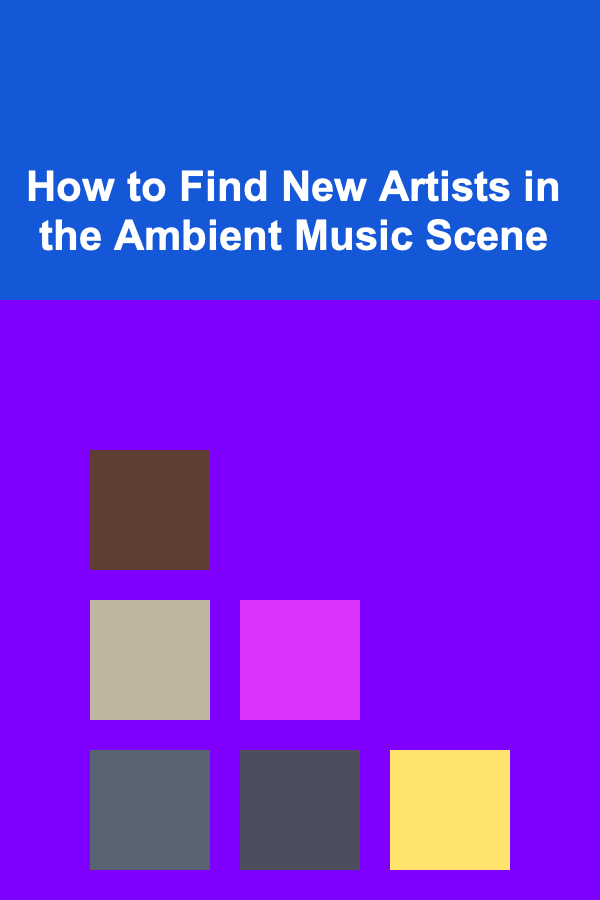
How to Photograph Planetary Nebulae
ebook include PDF & Audio bundle (Micro Guide)
$12.99$5.99
Limited Time Offer! Order within the next:

Photographing planetary nebulae can be an exciting and rewarding experience for both amateur and professional astronomers. These distant, colorful clouds of gas and dust represent the remnants of stars that have reached the end of their life cycle. Capturing the stunning beauty of these objects, however, is no easy task. Planetary nebulae are often faint, distant, and require specialized equipment and techniques to photograph effectively.
In this article, we will explore the necessary tools, techniques, and steps to successfully photograph planetary nebulae, from the basics of astrophotography to advanced imaging techniques. Whether you're a beginner looking to dive into astrophotography or an experienced astronomer aiming to capture breathtaking images of these cosmic phenomena, this guide will provide insights into the process.
Understanding Planetary Nebulae
What are Planetary Nebulae?
Despite their name, planetary nebulae have no relation to planets. The term was coined in the 18th century because of the round, disk-like appearance of some of these objects, which resembled the shape of planets when viewed through early telescopes. In reality, planetary nebulae are clouds of gas and dust ejected by dying stars at the end of their life cycle.
Planetary nebulae are formed when a star, similar in mass to the Sun, exhausts its nuclear fuel. The outer layers of the star are expelled into space, while the core collapses into a dense white dwarf. The expelled material forms the nebula, which glows due to ionization caused by the intense radiation emitted by the hot core. These nebulae can vary in size, shape, and color, depending on the star's initial mass, age, and the surrounding environment.
Common Features of Planetary Nebulae
- Shape: Most planetary nebulae exhibit a roughly spherical or elliptical shape. Some, however, display complex structures such as rings, lobes, or even bipolar jets.
- Color: The colors of planetary nebulae are primarily determined by the ionization of different elements within the gas cloud. For example, hydrogen emits red light, while oxygen produces green or blue light.
- Size and Distance: Planetary nebulae can range in size from a few thousand to tens of thousands of light-years away from Earth. Their size and brightness often depend on their age and the energy of the central star.
Understanding these characteristics is important when attempting to photograph planetary nebulae, as they will influence the exposure times, filters, and imaging techniques you use.
Essential Equipment for Photographing Planetary Nebulae
Capturing planetary nebulae requires specialized equipment to overcome the challenges posed by their faintness and distance. Here's an overview of the essential gear you'll need.
Telescope
A good quality telescope is the primary tool for observing and photographing planetary nebulae. The size and quality of the telescope will significantly impact your ability to capture fine details and resolve faint nebulae.
- Aperture Size: The larger the aperture of your telescope, the more light it can gather, which is crucial for photographing faint nebulae. An aperture of at least 8 inches (200mm) is recommended for planetary nebulae, though larger telescopes (12 inches or more) will provide better results.
- Focal Length: Planetary nebulae are relatively small in the sky, so you'll need a telescope with a long focal length or a telescope with the ability to attach a camera for high magnification. A focal length between 1000mm and 2000mm is often ideal.
- Mount: A stable equatorial mount is necessary to track the movement of the stars as the Earth rotates. A mount with accurate tracking capabilities ensures that your telescope stays locked onto the nebula during long exposure times.
Camera
A camera is essential for capturing detailed images of planetary nebulae. There are two main types of cameras used in astrophotography:
- DSLR or Mirrorless Cameras: These are popular choices due to their versatility and ease of use. However, to achieve optimal results for planetary nebulae, they must be paired with appropriate lenses and telescope adapters.
- Dedicated Astrophotography Cameras: These specialized cameras, such as CCD or CMOS sensors, are designed specifically for astrophotography. They are more sensitive to faint light and provide higher image quality than consumer-grade cameras. These cameras are often cooled to reduce noise during long exposures.
Filters
Planetary nebulae emit light across a range of wavelengths, so using filters can help isolate specific emission lines to enhance the contrast and details in the image.
- Hydrogen-alpha Filter (Hα): This filter isolates the red emission line of hydrogen, which is often the most prominent feature in many planetary nebulae.
- Oxygen III Filter (OIII): This filter isolates the green/blue emission lines of doubly ionized oxygen, which can provide additional color contrast in the nebula.
- Sodium D Filter (Na D): This filter helps capture specific emissions from sodium in the nebula, though it's less commonly used for planetary nebulae.
Using a combination of filters will allow you to capture images in different wavelengths, providing more detailed and colorful representations of the nebula.
Image Processing Software
Once you've captured the raw images, you'll need software to process and enhance them. Some of the most popular image processing software includes:
- DeepSkyStacker: A free program used to align and stack multiple images, increasing the signal-to-noise ratio and revealing faint details in the nebula.
- PixInsight: A powerful, professional-grade image processing tool designed specifically for astrophotography. PixInsight provides advanced features such as noise reduction, color calibration, and gradient removal.
- Photoshop: While not designed specifically for astrophotography, Photoshop is widely used for final adjustments and artistic enhancement of astrophotography images.
These programs will help you combine multiple exposures, adjust color balance, and bring out the finer details in your photos.
Choosing the Right Planetary Nebulae to Photograph
There are thousands of planetary nebulae scattered throughout our galaxy, but not all of them are equally easy to photograph. Some are more accessible, brighter, or more visually interesting than others. When selecting a planetary nebula to photograph, consider the following factors:
Brightness and Accessibility
Start by targeting brighter planetary nebulae that are relatively easy to locate. Some of the brightest and most famous planetary nebulae include:
- The Ring Nebula (M57): One of the most iconic planetary nebulae, located in the constellation Lyra. It is relatively bright and can be easily captured with moderate-sized telescopes.
- The Dumbbell Nebula (M27): Located in the constellation Vulpecula, this is another popular planetary nebula that is bright and easy to photograph.
- The Helix Nebula (NGC 7293): Often referred to as the "Eye of God," the Helix Nebula is a large and relatively bright nebula in the constellation Aquarius. It is one of the closest planetary nebulae to Earth, making it a popular target for astrophotographers.
Field of View
Some planetary nebulae are small and may require high magnification to capture their details, while others may fit well within the field of view of a moderate telescope. Be sure to select a nebula that fits your equipment's capabilities. If your telescope has a narrow field of view, you may need to capture multiple images and stitch them together in post-processing.
Capturing the Image: Exposure Techniques
Now that you have the necessary equipment and have selected a planetary nebula, it's time to capture the image. Astrophotography of nebulae typically involves long exposure times, stacking multiple frames, and careful attention to details like tracking and focus.
Setting Up for the Shot
- Focus: Achieving perfect focus is crucial for capturing sharp details of the planetary nebula. Use a Bahtinov mask or a focusing aid to ensure precise focus. Focus on a bright star near the nebula and then adjust until the star appears sharp in the image.
- Polar Alignment: Ensure that your mount is accurately polar aligned. This will minimize the movement of the stars during long exposures and reduce the risk of star trails.
- Test Exposures: Begin by taking test exposures of about 30 seconds to 1 minute. These short exposures allow you to check your settings, adjust the framing, and ensure the nebula is within the field of view.
Exposure Time
Planetary nebulae are faint, so you'll need long exposure times to capture enough light. Exposure times can range from 5 minutes to 20 minutes or more, depending on the brightness of the nebula and the sensitivity of your camera. It's a good idea to take multiple exposures to improve the signal-to-noise ratio, which can then be stacked later in processing.
Stacking the Images
To improve the final image quality, you will need to stack multiple exposures. This process involves aligning and combining several frames to reduce noise and reveal more detail. The more frames you stack, the better the final image will be, as stacking increases the signal-to-noise ratio.
Use software like DeepSkyStacker or PixInsight to stack your images. These programs automatically align and combine the images, creating a single high-quality image.
Post-Processing: Enhancing Your Image
Once you've captured and stacked your images, post-processing is key to bringing out the best details in your planetary nebula photograph.
Basic Processing Steps
- Calibration: Apply dark frames, flat frames, and bias frames to remove noise, sensor artifacts, and uneven illumination from your images.
- Stretching the Image: Use histogram stretching to enhance the contrast and bring out the faint details of the nebula.
- Noise Reduction: Use noise reduction techniques to smooth out the image while preserving fine details.
- Color Enhancement: Adjust the color balance to bring out the nebula's natural hues, such as the reds of hydrogen and the greens or blues of oxygen.
Final Touches
Once you've processed the image to your satisfaction, use software like Photoshop to apply final adjustments. You can crop the image to focus on the most interesting parts of the nebula, enhance contrast, and add sharpening to fine details.
Conclusion
Photographing planetary nebulae is a challenging yet rewarding aspect of astrophotography. It requires patience, practice, and the right equipment, but the results can be spectacular. By understanding the nature of planetary nebulae, selecting the right tools, and applying proper techniques, you can capture stunning images that reveal the intricate beauty of these cosmic objects.
Whether you're an amateur astrophotographer just starting or an experienced photographer looking to capture more detailed images, the journey of photographing planetary nebulae is an exciting and educational endeavor. Keep experimenting, refining your techniques, and enjoying the beauty of the universe one shot at a time.

How to Build a Checklist for Negotiating the Terms of Partnership Agreements
Read More
How to Build a Portfolio of Home Rental Properties for Long-Term Success
Read More
How to Store and Organize Seasonal Decor
Read More
How to Use Customer Relationship Management (CRM) Tools to Make Money
Read More
The Art of the Cover Letter: Writing to Stand Out
Read More
How to Find New Artists in the Ambient Music Scene
Read MoreOther Products

How to Build a Checklist for Negotiating the Terms of Partnership Agreements
Read More
How to Build a Portfolio of Home Rental Properties for Long-Term Success
Read More
How to Store and Organize Seasonal Decor
Read More
How to Use Customer Relationship Management (CRM) Tools to Make Money
Read More
The Art of the Cover Letter: Writing to Stand Out
Read More